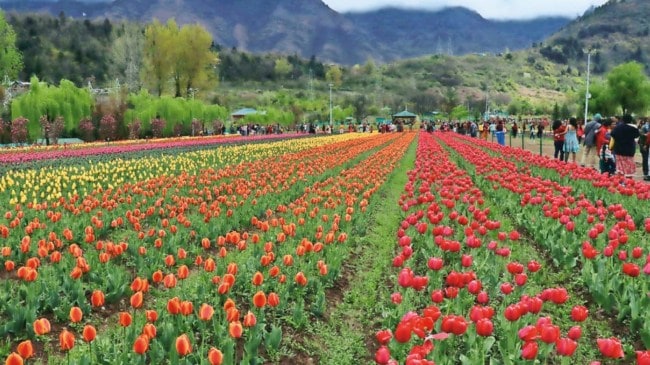Opinion Delhi’s tulip fever: Will it last?
The tulip in Delhi vanishes in mere days amid press and much fanfare, while nobody talks about the fragrant madhumalti and champa that lasts a whole season.
 In modern horticultural practice, there’s nothing more unfashionable than a neatly hedged flowerbed — the edgiest garden designers are always striving for the delicate balance between disorder and control.
In modern horticultural practice, there’s nothing more unfashionable than a neatly hedged flowerbed — the edgiest garden designers are always striving for the delicate balance between disorder and control. Like over the previous few years, the New Delhi Municipal Corporation will plant around 50,000 indigenous tulips in Delhi this winter. A portion of these were painstakingly developed at the Tulip Growth-cum-Storage Chamber at Lodi Gardens, set up in 2022. For a brief fortnight in March, commuters were treated to the visual spectacle of this famous Dutch import all along Shanti Path; alas, it didn’t last. This wondrous bulb is native to mountainous regions, so it fades quickly in the Capital’s semi-arid climes. The question begging to be asked is this: when most parks languish in a state of weedy neglect presumably for a lack of funds, why invest in this exotic and terribly expensive species that has such a fleeting bloom?
It’s entirely possible that the person in charge of choosing flowers for public spaces has great nostalgia for B R Chopra’s hit of the 1980s, Silsila, where Rekha and Amitabh Bachchan romance in Holland’s Keukenhof Gardens among a million glorious tulips, their pink and red petals tightly clenched. Or perhaps, in our ambitious, technocratic, perfectionist, perpetually optimising era, some NDMC official decided the ubiquitous marigold (gainda), or the petunias and dahlias that decorate the gol chakkars of Lutyen’s Delhi aren’t trendy enough. It fits in with the current political dispensation’s progress mindset that we’re moving determinedly upwards in our attainments — never mind if the faceless, nameless government maalis tasked with getting this European flower to bloom in dusty Delhi have to work thrice as much, for a depressingly short-lived success. If it’s tulips that we want, it’s tulips we shall have! Rows and rows of them!
In modern horticultural practice, there’s nothing more unfashionable than a neatly hedged flowerbed — the edgiest garden designers are always striving for the delicate balance between disorder and control. It may be too much to expect the NDMC to embrace the enchantment of wilderness. And undoubtedly, flowerbeds in a multitude of colors (however duly and dully placed), are a source of rare delight, in a city with smoky air and gray skies. However, this new-found love for tulips reveals, mostly, that the human capacity for self-deception is infinite. There is a startling arrogance about trying to coax the wrong flower to bloom in the wrong conditions. But it’s entirely in keeping with a world that values virality and sensationalism over quiet growth. The tulip in Delhi vanishes in mere days amid press and much fanfare, while nobody talks about the fragrant madhumalti and champa that lasts a whole season.
The first lesson gardening imparts is that wrestling with Mother Nature is futile. Just like sun-loving plants will droop in the shade and moisture-dependent saplings will dry out in a drought, in the garden and in life, the right environment matters. Appreciating, and working with the limitations of the weather and soil, leads to the best possible outcome, not following our own whimsical desires. Gardening is a perfect metaphor for how success depends on leaning on our strengths; and even then, so much lies beyond our control. To humbly accept that not every plant will survive, not every seed will sprout, is, in a sense, preparation for failure. On that thought, indeed, the experiment of tulip bulbs in Delhi may be deemed successful—they bloomed albeit briefly, citizens loved it—and at least somebody had the imagination to audaciously chase such ephemeral beauty.
The attempt is reminiscent of the movie Salmon Fishing in the Yemen, where a sheikh envisions the cold water fish spawning in a desert river. Like the tulips, it worked only tentatively. Maybe what’s important is the ability to dream up a new aesthetic vision, however improbable. That too, conveys something – that our society has the money and time to throw on the cultivation of tulips, which is not strictly speaking, necessary.
The writer is director, Hutkay Films





